#leucine
Text
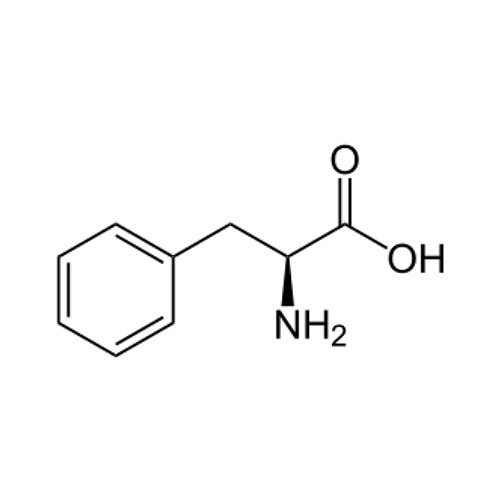
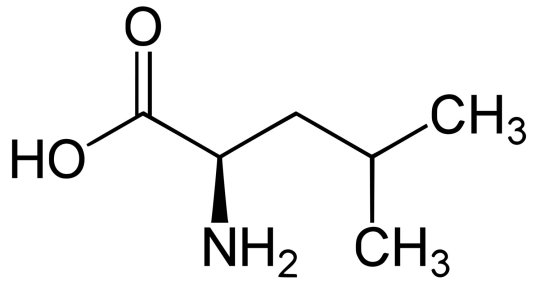
Aminoacid Swag Tournament Round 1
58 notes
·
View notes
Text
Figure 24.7 shows the analysis of a polypeptide hydrolysate by ion-exchange chromatography.
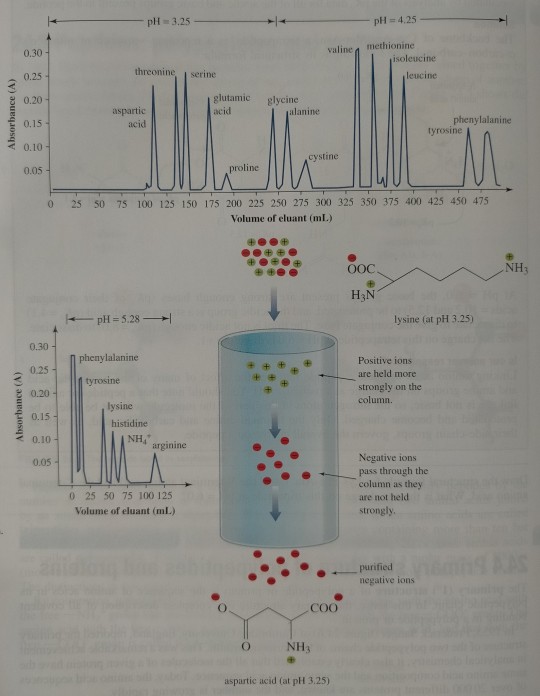
FIGURE 24.7 Analysis of a mixture of amino acids by ion-exchange chromatography using Amberlite IR-120, a sulfonated polystyrene resin. The resin contains phenyl-SO3-Na+ groups. The amino acid mixture is applied to the column at low pH (3.25), conditions under which the acidic amino acids (Asp, Glu) are weakly bound to the resin and the basic amino acids (Lys, His, Arg) are tightly bound. Sodium citrate buffers of two different concentrations and three different values of pH are used to elute the amino acids from the column. Cysteine is determined as cystine, Cy-S-S-Cys, the disulfide of cysteine.
"Chemistry" 2e - Blackman, A., Bottle, S., Schmid, S., Mocerino, M., Wille, U.
#book quotes#chemistry#nonfiction#textbook#polypeptide#hydrolysate#ion exchange#chromatography#resin#amino acid#aspartic acid#threonine#serine#glutamic acid#proline#glycine#alanine#cystine#valine#methionine#isoleucine#leucine#tyrosine#phenylalanine#cysteine#ions#amberlite
4 notes
·
View notes
Photo

Too Small Intestines
The rarity of some genetic disorders can make them difficult to study in patients. An animal model that replicates some of the disease mechanisms can help researchers, and a new study has developed the first zebrafish model for Feingold syndrome type 1, which causes incomplete development of the gastrointestinal tract among other symptoms. The condition is caused by mutations in the gene Mycn (stained green, active throughout the intestines of healthy fish, pictured). The mutant fish developed short intestines with reduced folding, and the deletion of Mycn impacted other genes as well, including those in a central regulator of protein synthesis, the mTOR signalling pathway. Supplementation with leucine, a building block that activates the mTOR pathway, helped restart protein synthesis and led to a partial recovery of intestine size. If the mechanisms translate to human biology, this simple supplement could bring relief to patients with Feingold syndrome type 1.
Written by Anthony Lewis
Image from work by Yun-Fei Li, Tao Cheng and colleagues
Zhejiang University School of Medicine, Hangzhou, China
Image originally published with a Creative Commons Attribution 4.0 International (CC BY 4.0)
Published in PLOS Biology, November 2022
You can also follow BPoD on Instagram, Twitter and Facebook
#science#biomedicine#intestines#gut#immunofluorescence#feingold syndrome#genetic disorders#mtor#leucine
6 notes
·
View notes
Link
0 notes
Text
The Role of Amino Acids in the Keto Diet: Unlocking the Key to Optimal Health
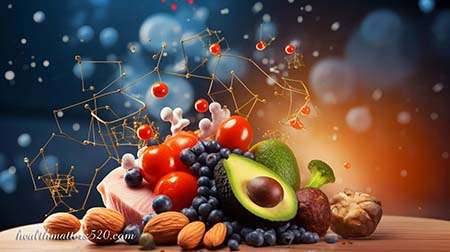
Are you interested in the relationship between amino acids and the ketogenic diet?
The keto diet has gained significant popularity due to its effectiveness in weight loss and overall health improvement. Amino acids, as the fundamental building blocks of proteins, play a crucial role in achieving and maintaining ketosis, the metabolic state that characterizes the keto diet. Understanding the connection between amino acids and ketosis can help optimize the benefits of this dietary approach.
In this article, we will explore the significance of amino acids in the keto diet and how they contribute to its success.
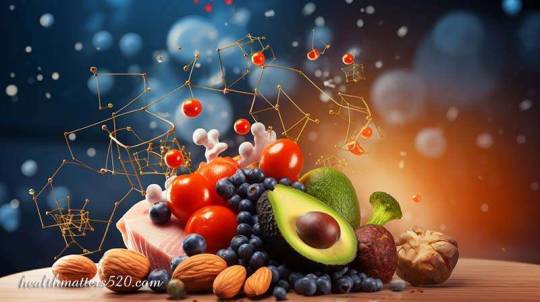
Understanding Amino Acids and Ketogenic Amino Acids
To comprehend the relationship between amino acids and the ketogenic diet, it's essential to grasp the basics of amino acids. Amino acids are the building blocks of proteins, and they are classified into three types: essential, non-essential, and conditional.
Essential amino acids are those that our bodies cannot produce on their own, so we need to obtain them from our diet. Non-essential amino acids, on the other hand, can be synthesized by our bodies. Conditional amino acids are usually non-essential, but under certain conditions (such as illness or stress), they become essential.
Ketogenic amino acids are a specific group of amino acids that have metabolic pathways leading to the production of ketone bodies. Ketone bodies are molecules produced during the breakdown of fatty acids, and they serve as an alternative source of energy when glucose is limited. These amino acids can be degraded into acetyl-CoA, a key component in ketone body production.
Understanding the role of ketogenic amino acids is crucial in the context of the ketogenic diet, as they provide an additional source of fuel for the body to enter and maintain a state of ketosis. This metabolic state is characterized by elevated ketone levels and a shift from glucose to fat metabolism.
The Science Behind Amino Acids and the Ketogenic Diet
Scientific research provides substantial evidence supporting the connection between amino acids and the ketogenic diet. One study published in ScienceDirect explored the role of ketogenic amino acids in promoting ketosis and its benefits for overall health.
Specific amino acids, such as lysine and leucine, have been found to play a crucial role in energy production and weight loss during ketosis. Lysine, for example, is involved in the synthesis of carnitine, a molecule that helps transport fatty acids into the mitochondria for energy production. Leucine, on the other hand, stimulates protein synthesis and supports muscle growth, which is particularly important during weight loss.
Another study published in PubMed Central focused on amino acid metabolism in ketogenesis and its potential role in nutritional neurotoxicity. It highlighted how the metabolism of amino acids, including both ketogenic and glucogenic amino acids, contributes to the production of ketone bodies for energy during the ketogenic diet.
Understanding the science behind amino acids and their impact on the ketogenic diet can provide valuable insights into optimizing energy production, weight loss, and overall health during ketosis.
Benefits of Ketogenic Amino Acids in the Keto Diet
Incorporating ketogenic amino acids into a keto diet plan can offer several potential benefits for individuals following this dietary approach. These amino acids can enhance weight loss, improve metabolic health, and support muscle growth.
Ketogenic amino acids, such as lysine and leucine, have been found to promote weight loss by increasing fat oxidation and reducing appetite. By stimulating the breakdown of fatty acids and the production of ketone bodies, these amino acids can help individuals reach and maintain a state of ketosis, leading to more efficient fat burning.
Furthermore, ketogenic amino acids play a role in improving metabolic health. They can support insulin sensitivity, which is crucial for regulating blood sugar levels and preventing insulin resistance. This can be particularly beneficial for individuals with metabolic disorders or those at risk of developing type 2 diabetes.
Additionally, these amino acids contribute to muscle growth and preservation. Leucine, in particular, activates protein synthesis and helps maintain muscle mass during weight loss. By supporting lean muscle retention, ketogenic amino acids can assist in achieving a toned and fit physique.
By incorporating ketogenic amino acids into a keto diet plan, individuals can potentially experience enhanced weight loss, improved metabolic health, and better muscle growth and preservation.
Practical Tips for Including Ketogenic Amino Acids in Your Diet
Incorporating foods rich in ketogenic amino acids into a keto meal plan can be a great way to optimize your dietary intake. Here are some practical tips for including these amino acids in your diet:

- Focus on Protein Sources: Choose high-quality protein sources that are rich in ketogenic amino acids. Foods like meat, poultry, fish, eggs, and dairy products are excellent choices. Opt for lean cuts of meat and fish, and consider including plant-based protein sources like tofu and tempeh for variety.
- Emphasize Lysine-Rich Foods: Lysine is an essential amino acid that plays a crucial role in the ketogenic diet. Include lysine-rich foods such as lean meats, fish, poultry, legumes (like beans and lentils), quinoa, and dairy products like Greek yogurt and cottage cheese.
- Incorporate Leucine-Rich Foods: Leucine is another important ketogenic amino acid that supports muscle growth and protein synthesis. Include foods like lean beef, chicken breast, tuna, salmon, eggs, and dairy products in your meals to ensure an adequate intake of leucine.
- Consider Amino Acid Supplementation: If you struggle to meet your amino acid needs through diet alone, consider amino acid supplementation. Consult with a healthcare professional or nutritionist to determine the appropriate dosage and type of amino acid supplement for your specific needs.
- Experiment with Keto-Friendly Recipes: Explore keto-friendly recipes that incorporate foods rich in lysine, leucine, and other essential amino acids. For example, you can try grilled chicken or fish with a side of steamed vegetables, or a Greek yogurt parfait topped with nuts and seeds for added protein.
By following these practical tips, you can ensure that your keto diet includes an adequate amount of ketogenic amino acids, promoting optimal health and achieving your goals.
Note: It is always recommended to consult with a healthcare professional or nutritionist before making any significant changes to your diet or incorporating supplements.
Conclusion
In the context of the ketogenic diet, amino acids play a crucial role as the building blocks of proteins and key contributors to achieving ketosis. Incorporating ketogenic amino acids into your keto diet can offer numerous potential benefits, including enhanced weight loss, improved metabolic health, and support for muscle growth.
By focusing on protein sources rich in lysine, leucine, and other essential amino acids, you can optimize your amino acid intake within the context of a keto meal plan. Additionally, considering amino acid supplementation under the guidance of healthcare professionals or nutritionists can help ensure you meet your specific needs.
It is important to remember that individual requirements may vary, and personalized advice from healthcare professionals or nutritionists is invaluable. They can provide tailored guidance and support to help you implement amino acids into your keto diet effectively and safely.
By understanding the significance of amino acids and seeking professional guidance, you can maximize the potential benefits of incorporating ketogenic amino acids into your keto diet, supporting your overall health and weight loss journey.
FAQ
Are all amino acids ketogenic? No, not all amino acids are ketogenic. Some amino acids are considered glucogenic, meaning that they can be converted into glucose for energy. Ketogenic amino acids, on the other hand, can be broken down into ketone bodies, which are used as an alternative source of energy during ketosis. Can I get enough amino acids on a ketogenic diet without supplementation? Yes, it is possible to get enough amino acids on a ketogenic diet without supplementation. By incorporating protein-rich foods such as meat, poultry, fish, eggs, and dairy products into your diet, you can meet your amino acid requirements. However, if you have specific nutritional needs or struggle to meet your amino acid needs through food alone, consulting with a healthcare professional or nutritionist about supplementation may be beneficial. Are there any risks or side effects associated with amino acid supplementation on a keto diet? Amino acid supplementation is generally considered safe when used appropriately. However, it is important to consult with a healthcare professional or nutritionist before starting any supplementation regimen. Excessive amino acid intake may have potential side effects, such as digestive issues or imbalances in other nutrients. Proper dosage and individualized advice can help minimize risks and ensure safe and effective supplementation. Can amino acid supplementation help with muscle building on a ketogenic diet? Yes, amino acid supplementation can support muscle building on a ketogenic diet. Amino acids, especially leucine, play a crucial role in stimulating protein synthesis and supporting muscle growth. By ensuring an adequate intake of essential amino acids, individuals on a keto diet can support their muscle-building goals. Can amino acids help with weight loss on a ketogenic diet? Amino acids, particularly those that are ketogenic, can potentially aid in weight loss on a ketogenic diet. Ketogenic amino acids contribute to the production of ketone bodies, which can increase fat burning and promote weight loss. Additionally, protein-rich foods that provide essential amino acids can help increase satiety and support appetite control, which can aid in weight management. However, it is important to maintain an overall balanced and calorie-controlled diet for successful weight loss.
Read the full article
0 notes
Text
Scientists make advancements in the detection of voice disorders using adversarial continual learning

- By InnoNurse Staff -
Voice disorders encompass various conditions like dysphonia, paralysis, cysts, and even cancer, which result in abnormal vibrations in the vocal cords or vocal folds.
Read more at Gwangju Institute of Science and Technology/Tech Xplore
///
Other recent news and insights
Leucine aims to simplify drug manufacturing compliance (TechCrunch)
#voice technology#ai#artificial intelligence#pathology#medtech#health tech#leucine#manufacturing#pharma#machine leaning#compliance
0 notes
Text
mTOR
"Under nutrient-rich conditions mTORC1 promotes cell growth by stimulating biosynthetic pathways, including synthesis of proteins, lipids and nucleotides, and by inhibiting cellular catabolism through repression of the autophagic pathway.
"The convergence point of anabolic and catabolic processes is the mechanistic target of rapamycin (mTOR), which senses fluctuations in extracellular and intracellular nutrients to modulate cellular growth, metabolism and survival.
"Cellular demands for amino acids are cell- and tissue-specific; while glutamine is an important energy source feeding the tricarboxylic acid (TCA) cycle particularly in glycolysis-dependent tumour cells [41], arginine influx and arginase levels are tightly regulated in liver for the urea cycle [42].
"Leucine, glutamine and arginine have been widely shown as the main contributors to mTORC1 activation [43–47]. In particular, glutamine, in addition to serving as a key energy source, cooperates with leucine to activate mTORC1. Glutamine can be deaminated to produce α-ketoglutarate, which is both an intermediate in the TCA cycle and a regulator of mTORC1 activity and autophagy. However, this reaction requires the presence of leucine, which acts as a cofactor of the enzyme that catalyses the last step of glutaminolysis [48].
"It is now clear that cellular homoeostasis of metabolism and growth is exquisitely controlled by the coordination of AMPK and mTORC1. AMPK is crucial to the cellular response to low energy levels and, once active, drives processes which will replenish cellular energy stores, such as autophagy while inhibiting biogenic synthesis [116]. Opposite to AMPK, activated mTORC1 shifts the metabolic programme of the cell from catabolic to anabolic metabolism by up-regulating the synthesis of building blocks for cell proliferation, including proteins, lipids and nucleotides [117].
"Whereas the role of amino acids as key signal factors in the activation of mTORC1 has been accepted, to date, the inhibitory effect of amino acids on AMPK has been a debatable issue. Some studies have observed the inhibition of AMPK by amino acids [124–126], though this has not always been the case [127,128]. A recent work suggests amino acids as novel metabolic activators of AMPK. In this study, AMPK responded acutely and within 1 min to amino acid and its activation was independent of mTORC1 [129]. ... Furthermore, they demonstrate that AMPK activation occurs via the Ca2+/calmodulin-dependent kinase kinase-β (CaMKKβ) and that activation of the CaMKKβ–AMPK axis by amino acids does not inhibit mTORC1 but sustains autophagy."

0 notes
Text
XXTRM OPTIMAL BCAAs 2:1:1 | GLUTAMINE | ELECTROLYTES (300G/0.66LB) | BOLT NUTRITION
XXTRM is An Amino Blast formula that contains GLUTAMINE, Optimal BCAAs ratio of 2:1:1 (Leucine, Isoleucine, and Valine) Plus Electrolyte blend a Performance driven Amino Blast Formula. You can fuel your workout with XXTRM Amino Blast which provides faster nutrient absorption into the bloodstream, hydration, and instant energy.
#BCAAs#glutamine#electrolyte#electrolytes#leucine#isoleucine#valine#glutamine powder#branched chain amino acids#bcaa amino acids#glutamine supplement#glutamine price#use of glutamine#electrolytes are#leucine amino acid#isoleucine amino acid#energy booster#energy boost#boost energy#energy boost supplement#stay hydrate#hydrated#keep yourself hydrated#keep hydrated#Muscle recovery#muscle recovery supplements#best muscle recovery supplements#intense workout#protein synthesis#muscle protein synthesis
0 notes
Photo

Hitting the weights real hard?? 👀 Pushing yourself toward that new PR? Time to reach for Enhanced Performance Nutrition's Intra Energy BCAA's. These amino acids are the key to preventing muscle breakdown after intense workouts. Branched-chain amino acids are the most important essential aminos for muscle recovery, growth, and increased performance. Take them before, during, or after your workout for fast absorption and a potent dose of recovery and strength. This refreshing drink is also great for all-day sipping to contribute to keeping your body in an anabolic state throughout the day. Key Ingredients L-Leucine L-Isoleucine L-Valine L-Glutamine Ep-Nutrition.com #bcaa #powder #dietary #supplement #preworkout #postworkout #leucine #valine #glutamine #weighttraining #weightlifting #intra #energy #epn #nutrition #aminoacids #intense #workouts #recovery #growth #buildmuscle #strength https://www.instagram.com/p/CmBDCL-O9Tg/?igshid=NGJjMDIxMWI=
#bcaa#powder#dietary#supplement#preworkout#postworkout#leucine#valine#glutamine#weighttraining#weightlifting#intra#energy#epn#nutrition#aminoacids#intense#workouts#recovery#growth#buildmuscle#strength
1 note
·
View note
Text
GNC AMP Gold Series - 100% Whey Protein Advanced

🟩 25 grams of protein
🟩 5.5 grams of BCAAs
🟩 2.6 grams of Leucine
*Available in different flavors
🍫 DOUBLE RICH CHOCOLATE
🍦 VANILLA ICE CREAM
🍓 DELICIOUS STRAWBERRY
.
Order now on our official website, link below ⤵️.
🌐 www.bodybuildingindia.com
Or https://bit.ly/3UjaWrx
.
.
For more information:
📞18008900224
#"#bbi#bodybuildingindia#indianbodybuilding#bodybuildinglifestyle#bodybuildingcom#bodybuildingnation#aminoacid#BCAAs#protein#WHEYprotein#WHEY#Leucine#bodybuildinglifesyle#bodybuildingnatural#bodybuildingtips
0 notes
Text
Table 24.2 gives pKa values for each ionisable group of the 20 protein-derived amino acids. (...) The isoelectric points for common amino acids are given in table 24.2.

"Chemistry" 2e - Blackman, A., Bottle, S., Schmid, S., Mocerino, M., Wille, U.
#book quotes#chemistry#nonfiction#textbook#ionization#amino acid#alanine#arginine#asparagine#aspartic acid#cysteine#glutamic acid#glutamine#glycine#histidine#isoleucine#leucine#lysine#methionine#phenylalanine#proline#serine#threonine#tryptophan#tyrosine#valine#isoelectric
0 notes
Link
Pterostilbene is a natural Pterostilbene and L-Leucinefound in flowers, fruits and vegetables. It is also produced by the body when we eat these plant-based foods. In the presence of an enzyme called esterase, pterostilbene becomes an essential component of the human body that helps maintain healthy cells and tissues. The compound also plays a role in cell repair and maintenance as it boosts the production of proteins that play a critical role in this process. Pterostilbene benefits come from its ability to improve overall health. This article will highlight some of pterostilbene’s advantages and explain why you should add it to your diet. Read on to learn more about this supplement... [caption id="attachment_1506" align="aligncenter" width="558"] The Benefits of Pterostilbene and L-Leucine[/caption] The Benefits of Pterostilbene and L-Leucine: Pterostilbene and L-Leucine: Pterostilbene Improves Heart Health Pterostilbene is a polyphenol that helps prevent heart disease by strengthening the walls of your blood vessels. This compound works by increasing nitric oxide levels, which are responsible for dilating and widening the blood vessels. Pterostilbene also reduces inflammation in the body and prevents oxidative stress, which ultimately leads to improved overall health. Pterostilbene modulates blood pressure and cholesterol levels, preventing them from rising too high. When your cholesterol levels fall, it prevents plaque buildup in the arteries, which reduces the risk of stroke or heart attack. It also improves growth hormone production, which helps maintain muscle mass as well as reduce body fat levels. Lastly, pterostilbene can help lower risk factors associated with diabetes and other metabolic conditions. In fact, it has been shown to help people with type 2 diabetes by reducing insulin resistance and improving beta cell function in their pancreas. [caption id="attachment_1508" align="alignleft" width="162"] The Benefits of Pterostilbene and L-Leucine[/caption] The Benefits of Pterostilbene and L-Leucine: Pterostilbene and L-Leucine: Pterostilbene Boosts Immunity Pterostilbene has the potential to improve immune function and treat infections. This article will discuss how pterostilbene is beneficial for people with compromised immune systems, including those with HIV/AIDS. Read on to learn more about this supplement... Pterostilbene also helps fight against oxidative stress and inflammation, which can help maintain healthy cells and tissues. Pterostilbene and L-Leucine: Pterostilbene Reduces Inflammation One of the most significant benefits of pterostilbene is that it can reduce inflammation. It does this by being able to create red blood cells and repair damaged DNA. Pterostilbene is a helpful supplement because it has been shown to have anti-inflammatory effects. This means that at the time of inflammation, pterostilbene can help to reduce your risk of developing chronic diseases like cancer. The compound also helps to stop the progression of heart disease and stroke. Pterostilbene and L-Leucine: Pterostilbene Supports Cancer Prevention Pterostilbene has been proven to play an important role in cancer prevention through its antioxidant activity. The polyphenol is believed to protect the human body from DNA damage induced by free radicals. This can be achieved by upregulating the expression of genes involved in cell cycle regulation and apoptosis. Pterostilbene also helps lower the risk of neurodegeneration by inhibiting oxidative stress and apoptosis-induced neurodegeneration. Research studies have shown that it can decrease inflammation, which also plays a role in neurodegeneration. It’s also capable of stimulating cellular regeneration, which protects neurons from radical-induced toxicity. [caption id="attachment_1509" align="alignright" width="163"] The Benefits of Pterostilbene and L-Leucine[/caption] Pterostilbene and L-Leucine: Other Benefits of Pterostilbene Pterostilbene is a polyphenol, which means it has antioxidant properties. This compound has been found to help fight against inflammation and disease. It’s also been reported to prevent Alzheimer’s from impacting your brain. Pterostilbene is even claimed to help reduce body fat and increase muscle mass. 1: Pterostilbene can be used in skin care products 2: Pterostilbene promotes cellular repair and maintenance 3: The compound plays a role in cell repair and maintenance by boosting the production of proteins that play a critical role in this process 4: Pterostilbene benefits come from its ability to improve overall health Pterostilbene and L-Leucine: Variations in Stable pterostilbene Formulas There is a diverse range of supplements that contain pterostilbene. These supplements vary in the amount, dosage and potency of the compound. Pterostilbene can be found in supplement form, or it can also be extracted and consumed as a food supplement. Some supplements use L-Leucine as the main ingredient and others use L-Arginine or L-Tyrosine as the primary ingredients. Some benefits of pterostilbene are: 1) It has been shown to increase levels of nitric oxide, which reduces blood pressure and improves heart health. 2) Increasing fertility because it increases levels of insulin-like growth factor (IGF)-1, follicle stimulating hormone (FSH) and luteinizing hormone (LH), which leads to increased sperm production. 3) Improves energy by improving circulation and increasing oxygenation in the body’s cells. Pterostilbene and L-Leucine: Safety of pterostilbene Pterostilbene is a natural polyphenol, meaning there are no known adverse effects on the human body. It is also deemed safe because it has been used in traditional medicine for centuries. The safety of pterostilbene makes it an ideal supplement for those seeking to improve overall health and reduce their risk of chronic diseases. https://youtu.be/Xw2Zl2r4toM Leucine is an amino acid with powerful muscle building properties, due mainly to the role it plays with mTOR. In this video you'll learn about the benefits of supplementing L-Leucine and the top foods which contain Leucine. I’m sure you are familiar with protein and just how important it is… people often say things like, proteins are the building blocks of the body. In reality though, the true building blocks of the body are what the protein is actually made up of, which is a selection of various amino acids. All of these amino acids serve different purposes within the body. Because of this, in order for a food to be considered an adequate protein source , a food needs to contain all nine of the essential amino acids necessary for the dietary needs of humans or other animals As I said each of these essential amino acids has a different function in the body….. so what would happen if you were to cherry pick the amino acid with the greatest benefits to muscle gain, and supplement with that. Then, you’d be supplementing Leucine, part of a family of three, known as the branched chain amino acids. Although you will sometimes hear about people supplementing with BCAAs, many studies have actually shown leucine is so beneficial, that it is better to supplement with just leucine, versus a mix of the three BCAAs This is why it is sometimes referred to as the 'main' amino acid due to the most popular benefit of BCAAs (muscle building) being mostly due to leucine. Leucine activates the mTOR pathways, which then induces muscle protein synthesis aka the building of muscle. Think of mTOR as the amino acid sensor of the cell. mTOR is sensitive to leucine concentrations. Decreasing leucine concentrations signal to mTOR that there is not enough dietary protein present to synthesize new skeletal muscle protein and it is deactivated. As leucine concentrations increase, it signals to mTOR that there is sufficient dietary protein to synthesize new skeletal muscle and mTOR is activated. While the other two BCAAs do also activate mTOR, they are much weaker than leucine in doing so (and as such, 5g of leucine will be more effective than 5g mixed BCAAs). When a food contains enough of all of the amino acids which we can only get through diet, it is said to be a complete protein source. But since these foods just need to meet certain minimum amino levels, they all have different levels of the different amino acids. This is why a gram of ‘protein,’ can mean something different depending on its source As an example, to be considered a complete protein , a food needs a minimum of just 7 mg of Tryptophan but it needs a minimum of 55 mg of leucine per gram of protein. This also means that while a gram of protein from one source may have 55mg of leucine, a gram of protein from another source could have 85 mg of leucine. Pterostilbene and L-Leucine: How to take pterostilbene? Pterostilbene is a supplement, so it must be taken orally. It is often added to smoothies and other foods because of this. However, as a more potent plant version of the molecule resveratrol, it can be taken in pill form as well. When taken in this manner, you can expect to see some benefits within an hour or two following ingesting the dose. Pterostilbene should not be taken with grapefruit juice as these two molecules react together and produce an unknown compound that may cause some side effects. Summary Pterostilbene is a natural polyphenol found in flowers, fruits and vegetables. It is also produced by the body when we eat these plant-based foods. In the presence of an enzyme called esterase, pterostilbene becomes an essential component of the human body that helps maintain healthy cells and tissues. The compound also plays a role in cell repair and maintenance as it boosts the production of proteins that play a critical role in this process. Pterostilbene benefits come from its ability to improve overall health. This article will highlight some of pterostilbene’s advantages and explain why you should add it to your diet. Read on to learn more about this supplement... Pterostilbenes are naturally occurring compounds found abundantly in plants, fruits and vegetables which are not only good for our bodies but our planet too! L-Leucine is one important amino acid that is made from two other amino acids: L-Isoleucine and L-Valine. It helps with protein synthesis which allows it to be used as a building block for many other compounds like neurotransmitters, hormones, enzymes, red blood cells and DNA during cellular processes necessary for life. Studies have shown that L-leucine can help people lose weight because it suppresses the appetite while at the same time increasing calorie burning through increased metabolism. Dr. Mercola Quercetin and Pterostilbene Advanced Dietary Supplement, 30 Servings (60 Capsules), Supports Lung and Immune Health, Non GMO, Soy Free, Gluten Free Buy Now 29.97 Each Bottle of Quercetin and Pterostilbene Advanced Contains 30 Servings Following Dr. Mercola’s belief in providing the best quality products, this product is Gluten free, GMO free, Soy Free Quercetin and Pterostilbene Advanced supports lung and bronchial tract health, cellular and mitochondrial health, cognitive function, athletic performance, heart health and more* Dr. Mercola Quercetin and Pterostilbene Advanced Dietary Supplement is ideal for long term, year-round use to help support immune health and your natural defense against seasonal threats* All Dr. Mercola products are backed by a full 90-day money back guarantee. If for any reason you are not satisfied with your purchase, simply return it to us for your money back - no questions asked Conquer Your Fear of 6 Top Health Risks for Men in 3 Simple Steps There are many natural ways to boost testosterone.
#MenOtherIssues#HeartHealthSupport#lleucinebenefits#lleucinepowder#lleucine#leucine#leucineaminoacid#leucinebenefits#leucinefoods#leucinesupplement#PterostilbeneandLLeucine#whatdoesleucinedo#whatisleucine
0 notes
Text
"Our study shows that dialing up your protein intake in pursuit of better metabolic health is not a panacea. You could be doing real damage to your arteries," said senior and co-corresponding author Babak Razani, M.D., Ph.D., professor of cardiology at Pitt. "Our hope is that this research starts a conversation about ways of modifying diets in a precise manner that can influence body function at a molecular level and dampen disease risks."
The study, which combined small human trials with experiments in mice and cells in a Petri dish, showed that consuming over 22% of dietary calories from protein can lead to increased activation of immune cells that play a role in atherosclerotic plaque formation, driving the disease risk. Furthermore, the scientists showed that one amino acid - leucine - seems to have a disproportionate role in driving the pathological pathways linked to atherosclerosis, or stiff, hardened arteries.
#protein#metabolism#atherosclerosis#health#science#diet#nutrition#healthcare#healthy eating#healthy living#health and wellness#leucin
3 notes
·
View notes
Text

Yes, that particular meme
#leucine s naturae#cysteine chappelle#oc#lesbian#drawing#meme#booba#face in booba#yes#i regret nothing
4 notes
·
View notes
Text
Branched-Chain Amino Acids (BCAAs): Benefits and Sources

Are you looking to enhance your muscle growth, improve exercise performance, and boost your overall well-being? Look no further than branched-chain amino acids (BCAAs). These essential nutrients have taken the fitness and health industry by storm, thanks to their potential benefits in protein synthesis, muscle repair, and more. In this blog post, we will delve into the world of BCAAs, exploring their incredible advantages and providing you with reliable sources to easily incorporate them into your diet. Get ready to unlock the secrets of BCAAs and take your fitness journey to new heights!
Understanding BCAAs
BCAAs, or branched-chain amino acids, are a group of three essential amino acids: leucine, isoleucine, and valine. These amino acids are considered "essential" because our bodies cannot produce them on their own, so we must obtain them through our diet or supplements.
BCAAs play a vital role in our body's protein synthesis process, which is crucial for muscle growth and repair. When we engage in physical activity or exercise, our muscles undergo stress and micro-tears. BCAAs help stimulate protein synthesis, allowing our muscles to recover and rebuild stronger.
Leucine, one of the three BCAAs, is particularly significant in muscle protein synthesis. It activates a pathway in our body known as the mammalian target of rapamycin (mTOR), which triggers the synthesis of new muscle proteins. Isoleucine and valine also contribute to protein synthesis and provide additional support for muscle recovery.
In addition to their role in muscle growth, BCAAs also help reduce muscle breakdown during intense exercise or periods of calorie restriction. They serve as an energy source for our muscles, helping to preserve muscle mass and prevent muscle wasting.
Understanding the importance of BCAAs in protein synthesis, muscle growth, and recovery can provide valuable insights into how these amino acids can optimize your fitness journey and overall well-being.
Benefits of BCAAs
BCAAs have been researched extensively, and the following benefits have been associated with their consumption:

Improved muscle recovery and reduced muscle soreness: BCAAs have shown potential in speeding up the recovery process after intense exercise. They help reduce muscle damage and alleviate post-workout muscle soreness, allowing you to bounce back faster and get back to your fitness routine.
Enhanced exercise performance and endurance: BCAAs can be a valuable tool to enhance exercise performance. They provide an additional energy source during workouts, delaying the onset of fatigue and improving endurance. By reducing the perception of fatigue, BCAAs may help you push through challenging workouts and reach your fitness goals.
Potential aid in weight loss and fat burning: BCAAs have been suggested to support weight loss efforts. They can help preserve lean muscle mass during calorie-restricted diets, preventing muscle breakdown. By preserving muscle, BCAAs contribute to an increased metabolic rate, potentially aiding in fat burning and maintaining a healthy body composition.
Reduced muscle wasting during calorie-restricted diets: When following a calorie-restricted diet, the body may break down muscle tissue for energy. BCAAs can help counteract this process by providing the body with an alternative energy source. By preserving muscle mass, BCAAs contribute to maintaining a toned physique during weight loss journeys.
Support for liver function in individuals with advanced liver disease: BCAAs have shown promise in supporting liver health. In individuals with advanced liver disease, known as hepatic encephalopathy, BCAAs may help improve brain function and reduce complications associated with liver dysfunction.
Potential reduction of symptoms in movement disorders caused by antipsychotic drugs: Some studies suggest that BCAAs might have a positive impact on movement disorders induced by antipsychotic medications. While further research is needed, BCAAs could potentially alleviate symptoms and improve the quality of life for individuals affected by these conditions.
By understanding the multiple benefits associated with BCAAs, you can harness their potential to optimize your fitness performance, aid in weight management, support liver health, and potentially improve certain movement disorders.
Reliable Sources of BCAAs
Incorporating natural food sources rich in BCAAs is essential for a well-rounded and balanced diet. Here are some reliable sources of BCAAs:

- Meat and poultry: Chicken, beef, and pork are excellent sources of BCAAs. These meats provide a complete protein profile, including all three essential amino acids: leucine, isoleucine, and valine. Choose lean cuts of meat to minimize saturated fat intake.
- Fish and seafood: Tuna and salmon are not only delicious but also packed with BCAAs. Additionally, other seafood options like shrimp and cod also contain significant amounts of these beneficial amino acids. Fish and seafood are also rich in omega-3 fatty acids, which offer additional health benefits.
- Dairy products: Milk, yogurt, and cheese are not only a great source of calcium but also provide BCAAs. Opt for low-fat or skim dairy products to reduce saturated fat intake while still benefiting from their BCAA content. Greek yogurt, in particular, tends to have higher BCAA levels.
- Legumes and beans: Lentils, chickpeas, and other legumes are plant-based sources of BCAAs. These vegetarian options are not only rich in protein and fiber but also provide a good amount of essential amino acids. They can be incorporated into various dishes, such as soups, salads, and stews.
By including these natural food sources in your diet, you can ensure a sufficient intake of BCAAs. Remember to prioritize a balanced diet that includes a variety of nutrient-dense foods to support your overall health and well-being.
BCAA Supplements
BCAA supplements are readily available in the market and are commonly used by individuals looking to optimize their fitness and muscle-building goals. However, it is crucial to consult with a healthcare professional before starting any supplementation.
While BCAAs can be obtained through natural food sources, some individuals may choose to supplement their intake for various reasons, such as convenience or specific dietary needs. Consulting with a healthcare professional ensures that supplementation is suitable for your individual circumstances and health status.
BCAA supplements are typically available in different forms, including capsules and powders. Capsules offer a convenient option for those who prefer a pre-measured dose and ease of consumption. On the other hand, BCAA powders can be mixed with water or other beverages, allowing for customization of dosage and flavor preferences.
Dosage recommendations for BCAA supplements can vary based on factors such as body weight, activity level, and specific goals. It is important to follow the instructions provided by the supplement manufacturer or seek guidance from a healthcare professional. Generally, a common recommendation is to consume a BCAA supplement with a ratio of 2:1:1 (leucine:isoleucine:valine).
Remember, supplements should complement a healthy diet and lifestyle, rather than replace them. It's essential to prioritize a balanced diet that includes a variety of whole foods to obtain essential nutrients, including BCAAs. Supplementation should be approached as a targeted addition to support specific goals, with guidance from a healthcare professional to ensure safety and effectiveness.
Conclusion
BCAAs offer numerous benefits in supporting muscle growth, exercise performance, and overall well-being. By promoting protein synthesis and muscle recovery, BCAAs contribute to enhanced muscle growth and reduced muscle soreness. They also provide an additional energy source, improving exercise performance and endurance. Moreover, BCAAs may aid in weight loss, support liver function, and potentially alleviate symptoms in certain movement disorders.
Incorporating BCAAs into your diet can be achieved through natural food sources such as meat, poultry, fish, dairy products, legumes, and beans. These whole foods provide a balanced approach to obtaining BCAAs, along with other essential nutrients. Additionally, BCAA supplements are available in the market, offering convenience and customization. However, it is crucial to consult with a healthcare professional before starting any supplementation to ensure suitability and proper dosage.
In conclusion, BCAAs play a vital role in optimizing fitness performance and overall well-being. By combining BCAAs from natural food sources and supplements, if necessary, you can support your fitness goals and maintain a balanced diet. It's important to make informed decisions based on your individual needs and seek personalized advice from professionals, such as healthcare providers or registered dietitians, for guidance tailored to your specific situation. Take charge of your health and unleash the power of BCAAs on your fitness journey!
FAQ
What are branched-chain amino acids (BCAAs)? BCAAs are a group of essential amino acids, including leucine, isoleucine, and valine. These amino acids are called "branched-chain" due to their unique molecular structure. They are essential because our bodies cannot produce them and must be obtained through our diet or supplements. BCAAs are particularly important for muscle growth, repair, and overall protein synthesis. How do BCAAs help with muscle recovery? BCAAs play a crucial role in muscle recovery after intense exercise. When we engage in physical activity, our muscles undergo stress and micro-tears. BCAAs help stimulate protein synthesis, allowing our muscles to repair and rebuild stronger. They also reduce muscle damage and alleviate post-workout muscle soreness, promoting faster recovery and getting you back on track for your next workout. Can BCAAs be beneficial for muscle recovery even without intense exercise? Yes, BCAAs can still be beneficial for muscle recovery even without intense exercise. They provide essential building blocks for muscle repair and growth. Whether you engage in strenuous workouts or have a more moderate exercise routine, BCAAs can support your muscles' recovery process and help maintain muscle mass. How should I take BCAAs for muscle recovery? The timing and dosage of BCAAs for muscle recovery can vary depending on individual needs and preferences. Some people prefer taking BCAAs before or during their workouts to provide immediate fuel and support for their muscles. Others may take BCAAs after their workouts to aid in the post-exercise recovery process. The recommended dosage typically ranges from 5 to 10 grams before or after exercise, but it's best to follow the instructions on the specific product or consult with a healthcare professional for personalized advice. Can I get enough BCAAs for muscle recovery from food alone? While it's possible to obtain BCAAs from natural food sources, such as meat, poultry, fish, dairy products, legumes, and beans, it may be challenging to achieve optimal levels for muscle recovery through food alone. BCAA supplements can provide a convenient and concentrated source of these amino acids. However, it's important to remember that supplements should complement a balanced diet and not replace whole foods. Consult with a healthcare professional to determine the best approach for incorporating BCAAs into your muscle recovery routine.
Read the full article
0 notes